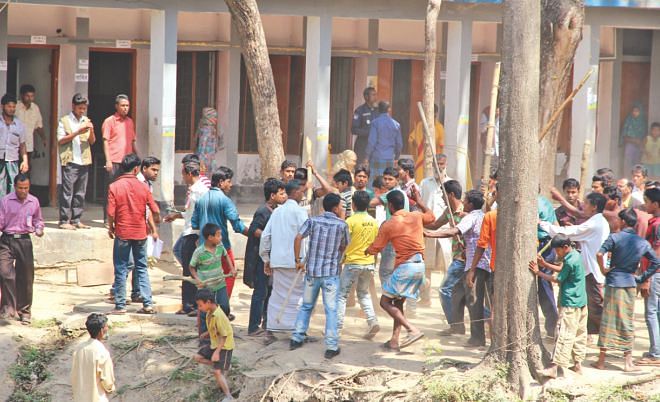Tackling election violence
Tackling election violence

ELECTION violence could be defined as 'any act or threat of physical or psychological harm to a person or damage to property, directed at anyone directly involved in an electoral process (voter, candidate, party officials, election worker, election monitor, journalist, etc.), which may disrupt or attempt to disrupt any aspect of the electoral process'. Election violence occurs most frequently between political rivals rather than between state actors and voters. It may involve competitive relationships between or among three types of actors: political rivals, state actors and supporters.
Election violence can compromise electoral integrity through its impact on candidate selections, voter turn-out, or the accuracy of the announced results. Persistent cases of electoral violence create obstacles to democratic consolidation as institutions of governance are under threat, compromised, or remain fragile as a direct or indirect result of the violence. Violence is one of the greatest threats to free and fair elections.
Similar to many other developing democracies, election violence is not new in Bangladesh. Since the 1st parliamentary election held in 1973, there have been some sorts of violence in every parliamentary and local government elections. In 2001, after the 8th parliamentary election, 52 people were killed and 867 people were injured in 10 days. In 2006, during the period 1-15 December 3 people were reportedly killed and 215 wounded in 34 cases of violence. Although in 2008, 336 people were injured and there was no deaths reported (Odhikar), in 2014 parliamentary election at least 18 people were killed on election day (Telegraph).
Election violence continues in the upazila elections. In the 1st phase upazila elections, as observed by Election Working Group (EWG) there were 20 cases of violence occurring inside the polling stations which included attempts by some to occupy the polling stations, unrest due to attempts to forge votes and acts of intimidation against voters. In the 2nd phase the incidence of violence was 131, while in the 3rd phase the number was 258.
Although, in the upazila elections, the incidence of violence is increasing day by day, we have not seen any effective measures from any quarter to control it. The Election Commission (EC) has the prime responsibility to tackle the election violence. Government agencies and security providers need to work with EC to mainstream security and electoral issues in multi-agency stakeholder settings, including developing strategic, comprehensive security plans and operational rooms.
In many countries, before every election, the Election Management Body (EMB) conducts risk assessments and mapping to manage the threats of election-related violence. In some countries, EMBs form community peace committees to tackle violence in the grass-root level.
Use of ICT in elections could reduce violence. In the 2008 general elections in Kenya, UNDP helped establish a toll-free SMS-based service that allowed citizens to report perceived threats to security. At a central level, SMS messages were analyzed and verified and responses initiated through partnerships between civil society groups and police. This gave police and other responders a level of localised information that was previously inaccessible. The same system of mobile-based reporting kept 2013 elections in Kenya relatively peaceful.
In order to mitigate electoral violence it is also important to identify the different types of electoral violence. Some violence aimed at disrupting elections by actors who do not want the elections to take place at all. This type of violence could be tackled by only by the national security forces through developing and implementing a proper plan.
Other type of election violence could be triggered by the rivalry between the contesting candidates/parties. This type of violence can be can be controlled by various measures such as: codes of conduct for political parties with strong sanctions penalizing electoral violence, intensive voter/civic education programmes concerned with election campaigns and polling, and also special programmes/ activities aimed at preparing parties and candidates for election loss. Furthermore, community based organizations and citizens can help in preventing both types of violence and should have a more prominent role in strategies and programmes aimed at the prevention of electoral violence.
EMBs have a role in establishing structures for all stakeholders taking part in elections, especially political parties and civil society organizations, which could also be used as a platform for discussions about preventive measures. All of this should be done within a transparent system.
Although the development partners often looks to elections to stabilize and legitimize government, elections often bring social tensions to a head and may trigger violence. Election-related violence is a unique form of conflict and requires specifically designed responses for effective prevention, mitigation and resolution. When we fail to recognize the uniqueness of election-related violence the burden of responding is too often placed on the shoulders of a few actors. Also it destroys the credibility of elections.
As EC has to go for three more rounds of the upazila elections, it should consider the proposals which will not only tackle election violence but also increase the integrity of the electoral process.
The writer is an international election expert; presently working as Director, Election Working Group. E-mail: aalim@ewgbg.org
Disclaimer: The views and opinions expressed in this article are those of the author's and do not necessarily reflect the official policy or position of Election Working Group.